The term Aztec comes from the word Aztecah which means “people from Aztlan”. Aztlan is a legendary place, which the Aztecs referred to their ancestral home. The Aztecs arrived in the Valley of Mexico and built one of largest and most powerful empires in Pre-Columbian Americas. Apart from their military might, the Aztecs were highly skilled engineers who build the marvelous city Tenochtitlan on one of the most difficult terrains. Their engineering achievements include the construction of a double aqueduct, a massive dike, causeways and artificial islands. Among other things, the Aztecs had a number system, a calendar, great knowledge of medicine and a rich tradition in poetry. They were also the first to implement universal compulsory education. Here are the 10 major accomplishments of the Aztecs including their cultural, scientific, engineering and military achievements.
#1 THEY BUILT ONE OF THE LARGEST EMPIRES IN MESOAMERICA
The Mexica were migrants who arrived in the Valley of Mexico around 1250 AD and founded the city of Tenochtitlan in 1325 AD. Initially they allied with and paid tribute to Azcapotzalco, the capital city of the Tepanec Empire. In 1426, the Azcapotzalco king arranged the assassination of the Mexica ruler. The following year Tenochtitlan allied with the city-states of Texcoco, Tlacopan, and Huexotzinco to wage war against Azcapotzalco. They emerged victorious in 1428. After the war, Huexotzinco withdrew. The other three city-states formed the Triple Alliance, with Tenochtitlan soon becoming the dominant power. The alliance waged wars of conquest and expanded rapidly after its formation. At its heights, the Triple Alliance or the Aztec Empire controlled most of central Mexico as well as other territories. It covered 80,000 square miles and contained 25 million people in almost 500 towns and cities. It was one of the largest and most powerful empires in the history of Mesoamerica, the region of Mexico and Central America prior to Spanish conquest. The term Aztec is often used to refer exclusively to the Mexica people of Tenochtitlan while some also include the inhabitants of its allies: the Acolhuas of Texcoco and the Tepanecs of Tlacopan.

#2 THE AZTECS WERE HIGHLY SKILLED ENGINEERS
When the Aztecs founded the city of Tenochtitlan in 1325, it was a small swampy island in Lake Texcoco in the Valley of Mexico. This posed a great challenge to the Aztecs as anything they would build would subside due to the geography of the region. They ingeniously met this challenge by pounding wooden piles into the lake bed below water in close packed formations to provide a firm foundation for their buildings. These pilings were surrounded by volcanic stone to add strength. The fact that their structures, built on top of these foundations, didn’t topple or sink bears testament to their amazing engineering skills. The only way to travel from Tenochtitlan to the mainland was by boat. The Aztecs connected their city to the mainland by building three causeways to the north, south and west. They did so by driving two lines of wooden stakes deep into the lake bed and filing the space between them with earth and stones till it reached water level. The causeways were built straight and were as wide as 45 feet. They were interrupted by bridges that would open up to allow boats to pass through and to defend the city in case of an invasion.
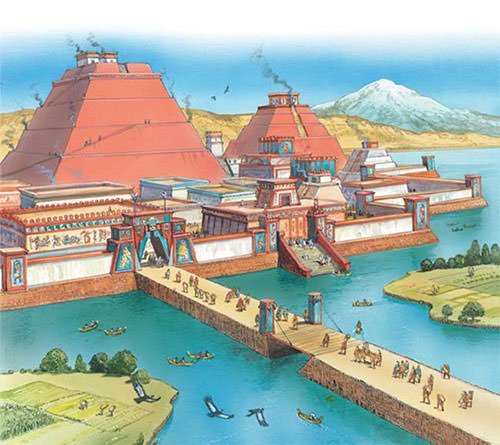
#3 THEY PERFECTED THE TECHNIQUE OF CREATING ARTIFICIAL ISLANDS
Chinampas, often referred to as floating gardens, were more accurately artificial islands. The Aztecs perfected the technique of building chinampas allowing them to create new land to farm and to live on. A chinampa was created by staking out the shallow lake bed and weaving the stakes together to form fences. The fenced-off area was then layered with mud, lake sediment and decaying vegetation, eventually bringing it above the level of the lake. Trees were often planted along the perimeter to stabilize the artificially built island. The chinampas at Tenochtitlan ranged from 90 m × 5 m (300 ft × 20 ft) to 90 m × 10 m (300 ft × 30 ft). The lake provided the chinampas with moisture laden with decomposing organic wastes that irrigated and fertilized the artificial island’s soil, supporting an intensive and highly productive form of cultivation. The chinampas could produce up to 7 crops a year allowing enough food for the rising population of the Aztec cities.
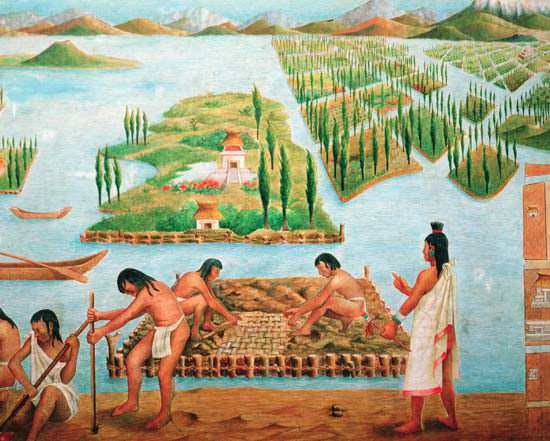
#4 THEY CONSTRUCTED A DOUBLE AQUEDUCT TO BRING FRESH WATER TO TENOCHTITLAN
As the Aztec population in Tenochtitlan grew so did the demand for fresh water. In the 1420s, they initiated the construction of the Chapultepec aqueduct to bring clean water to their city from the springs at Chapultepec on the mainland. The aqueduct had two channels each about 5 ft high and 3 ft wide. When one channel was being maintained, the other brought water to the city thus ensuring constant supply. The Chapultepec aqueduct ran for three miles and poured water into public fountains and reservoirs. It is considered a remarkable Aztec accomplishment as only a few ancient civilizations could master the engineering and construction of such a sophisticated aqueduct.
#5 THEY ENGINEERED A MASSIVE DIKE TO PROTECT THEIR CITY
Lake Texcoco was the largest of five interconnected lakes and thus Tenochtitlan was constantly under threat from the large quantity of water surrounding it. A catastrophic flood in the mid 1400s almost destroyed the whole city. To address the issue, the Aztecs designed a huge dike or dam with a height of around 12ft and running for around 10 miles from the southern edge of the lake to the north. Made of sticks, weeds and stone, it was the largest earthwork in the Americas at the time. It was fitted with doors which could be raised or lowered to control the level of water behind it. Apart from protecting Tenochtitlan from floods, the dike also kept the brackish waters beyond the dike, to the east.
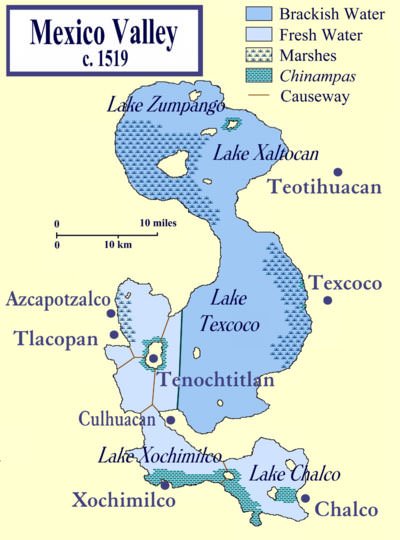
#6 TENOCHTITLAN WAS ONE OF THE GREATEST CITIES OF THE TIME
At its peak, Tenochtitlan was the largest city in the Pre-Columbian Americas. It covered an estimated area of 8 to 13.5 km2 and had an estimated population between 200,000 and 300,000. It held twice the population of London or Rome and was one of the largest cities in the world. The city was divided into four zones with each zone being further divided into 20 districts. At the center of the city was the Sacred Precinct which encompassed an area of almost 4,000 square meters (43,000 square feet) and was surrounded by a wall known as the “coatepantli” (serpent wall). The Sacred Precinct was dominated by Templo Mayor (“Main Temple”), a 60 m (180 ft) high pyramid with a base of approximately 100 by 80 m (328 by 262 ft). Templo Mayor was the focal point of Aztec religion and the most important building of their culture. Tenochtitlan; with its streets, causeways, canals, aqueducts, marketplaces, palaces and buildings like Templo Mayor; was one of the best constructed and most marvelous cities in the world at the time. When the Spanish first saw the place they were so enchanted by it that they doubted whether it was real or were they in a dream.
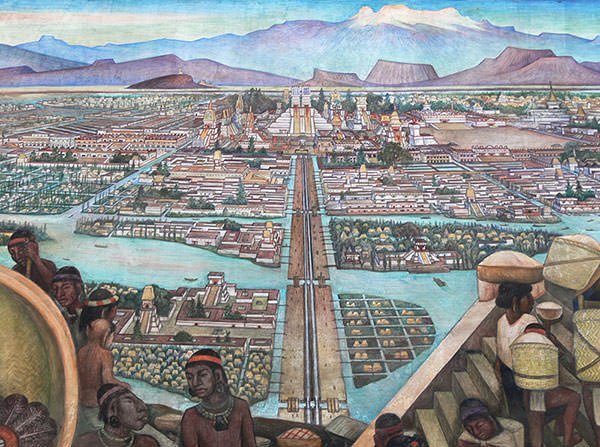
#7 THEY HAD A BASE 20 NUMBER SYSTEM AND A CALENDAR WITH TWO CYCLES
The Aztecs used a base 20 or vigesimal number system. Dots, or a combination of dots and bars, were used to represent quantities up to 20. A flag was used to indicate 20, repeating it for quantities up to four hundred. A sign like a fir tree signified 400 while a bag was used to represent 8000. Though they had a conceptual idea of 0, it is not known whether they had a symbol for it and thus 0 was not prevalent in their number system. The Aztecs had an understanding of multiplication and division as well as certain principles of geometry. Their standard unit for linear measurement was land rod, which corresponded to about 2.5 meters. Recent research has also shown that they used symbols such as an arrow, a heart, a hand, or a bone, to represent fractional distances when calculating areas of lands. The Aztec used a calendar which consisted of a 365-day calendar cycle called xiuhpohualli (year count) and a 260-day ritual cycle called tonalpohualli (day count). These two cycles together formed a 52-year “century”. The xiuhpohualli is considered to be the agricultural calendar while the tonalpohualli is considered to be the sacred calendar.
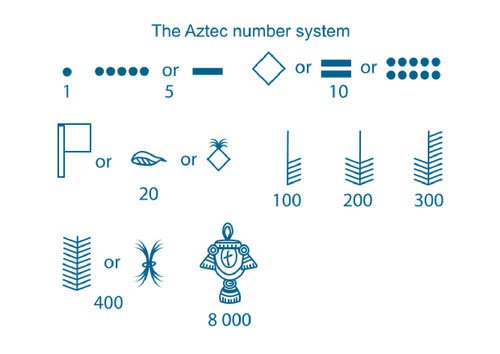
#8 THEY COULD PERFORM SURGERIES
Aztec physicians, known as tictils, were accomplished herbalists who did medicinal research. The Aztecs believed that there were three main causes of illness: punishment from an angry god or goddess; black magic inflicted by an enemy; or natural causes. They used an extensive inventory consisting of hundreds of different medicinal herbs and plants. They used the sap from the maguey tree as a disinfectant and to heal wounds; and Argemone mexicana as a painkiller. The Aztec performed surgeries using knives made of volcanic glass. They used traction and countertraction to reduce fractures; and sprains and splints to immobilize fractures. After the surgical process they often covered the wound with crushed plants to aid the healing process. They had great knowledge of entheogenic plants and animals. Apart from using them for prophetic and religious activities, they also used them in medicine. They used the passion flower as a type of antispasmodic medication to relax muscles during surgeries.

#9 THE AZTEC HAD A RICH TRADITION IN POETRY AND SCULPTURE
The highest form of art in the Aztec culture was song and poetry with their contests being held at most festivals. A key aspect of their poetry was parallelism, that is using a structure of embedded couplets to express different perspectives on the same element. The Aztec used to pass down their poetry verbally and it was only after the Spanish conquest that collections of their poems were made. The most famous among these is Romances de los señores de la Nueva España. The Aztec played various musical instruments including flute and drums. They were adept at carving sculptures in stone and wood in many sizes from small figurines to large monuments. The most famous work of Aztec sculpture is perhaps the Sun Stone, popularly but erroneously known as the Aztec calendar stone. The Aztec created a variety of beautiful pottery which had high demand in the Mesoamerican market. They also made jewelry from various materials including gold, silver, copper, jade and obsidian. Their most prized art was however feather-work, which was created by their artisans by weaving together brightly colored feathers to form cloaks, headdresses etc.

#10 THEy WERE THE FIRST TO PROVIDE UNIVERSAL COMPULSORY EDUCATION TO ALL CHILDREN
The Aztec Empire is regarded as the first state to implement a system of universal compulsory education. Every child was educated regardless of his or her social status, whether noble, commoner or slave. Education began at home with boys learning their fathers’ trades like hunting, farming, fishing etc.; and girls learning domestic chores. From the ages of 12 to 15, all children were required to attend schools where they learned ceremonial songs and history and culture of their civilization. Boys and girls attended different schools. Formal education for the girls usually ended at the age of 15. There were two schools for the boys after the age of 15: the Telpochcalli, the school for the poor and the Calmecac, the school for the nobles. The study at Telpochcalli was primarily military in nature but also included civics, history and religion. At Calmecac, military training was combined with religion, governing, astronomy, math, architecture, history, poetry, etc.

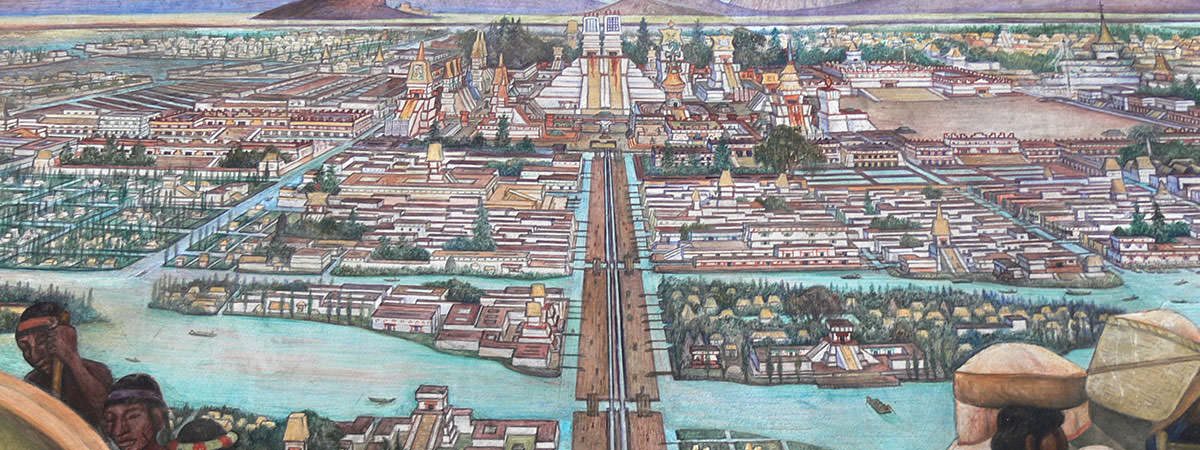
Love this site! Very well written and laid out.
Thanks for your appreciation.
lol I have whole lot of religion , I am Aztec, Maya, Inca, Native, Part Spain lol,
Xipe Totec